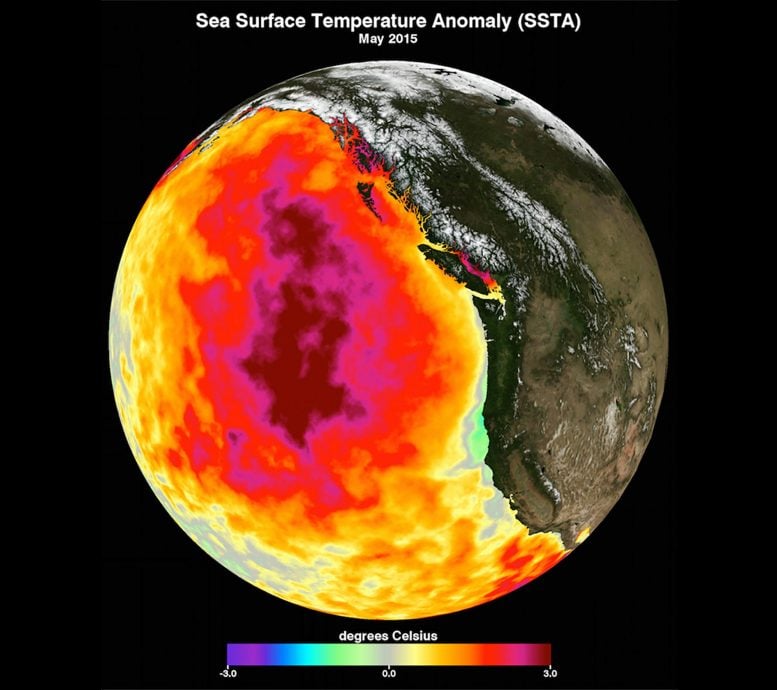人为海洋热浪的发生频率是过去的20倍以上
2020-10-19 09:18阅读:
Marine Heatwaves Are Human Made, Over 20 Times More
Frequent
人为海洋热浪的发生频率是过去的20倍以上
 This data image shows the monthly average sea
surface temperature for May 2015. Between 2013 and 2016, a large
mass of unusually warm ocean water – nicknamed the Blob – dominated
the North Pacific, indicated here by red, pink, and yellow colors
signifying temperatures as much as three degrees Celsius higher
than average. Data are from the NASA Multi-scale Ultra-high
Resolution Sea Surface Temperature (MUR SST) Analysis product.
Credit: Courtesy NASA Physical Oceanography Distributed Active
Archive Center
此数据图像显示了2015年
This data image shows the monthly average sea
surface temperature for May 2015. Between 2013 and 2016, a large
mass of unusually warm ocean water – nicknamed the Blob – dominated
the North Pacific, indicated here by red, pink, and yellow colors
signifying temperatures as much as three degrees Celsius higher
than average. Data are from the NASA Multi-scale Ultra-high
Resolution Sea Surface Temperature (MUR SST) Analysis product.
Credit: Courtesy NASA Physical Oceanography Distributed Active
Archive Center
此数据图像显示了2015年
5月的月平均海表温度。
在2013年至2016年之间,大量异常温暖的海水(绰号为Blob)在北太平洋占主导地位,此处以红色、粉红色和黄色表示,意味着温度比平均温度高三摄氏度。
数据来自NASA多尺度超高分辨率海面温度(MUR
SST)分析产品。
图片提供:NASA物理海洋学分布式活动档案中心
Heatwaves in the world’s oceans have become over 20
times more frequent due to human influence. This is what
researchers from the Oeschger Centre for Climate Research at the
University of Bern are now
able to prove. Marine heatwaves destroy ecosystems and damage
fisheries.
由于人类的影响,世界海洋中的热浪的发生频率已超过20倍。伯尔尼大学Oeschger气候研究中心的研究人员现在就可以证明这一点。
海洋热浪破坏了生态系统,也破坏了渔业。
A marine heatwave (ocean heatwave) is an extended
period of time in which the water temperature in a particular ocean
region is abnormally high. In recent years, heatwaves of this kind
have caused considerable changes to the ecosystems in the open seas
and at the coast. Their list of negative effects is long: Marine
heatwaves can lead to increased mortality among birds, fish, and
marine mammals, they can trigger harmful algal blooms, and greatly
reduce the supply of nutrients in the ocean. Heatwaves also lead to
coral bleaching, trigger movements of fish communities to colder
waters, and may contribute to the sharp decline of the polar
icecaps.
海洋热浪(ocean
heatwave)是在延长的一段时间里,特定海洋区域的水温异常高。近年来,这种热浪已导致公海和沿海地区的生态系统发生了巨大变化。它们的负面影响项清单很长:海洋热浪可以导致鸟类、鱼类和海洋哺乳动物的死亡率增加,它们可以引发有害的藻华,并大大减少海洋中的营养物供应。
热浪还会导致珊瑚白化,引发鱼类群落向较冷水域移动,并可能导致极地冰盖的急剧下降。
Researchers led by Bern-based marine scientist
Charlotte Laufkötter have been investigating the question of how
anthropogenic climate change has been affecting major marine
heatwaves in recent decades. In a study recently published in the
well-known scientific journal “Science”, Charlotte Laufkötter,
Jakob Zscheischler and Thomas Frölicher concluded that the
probability of such events has increased massively as a result of
global warming. The analysis has shown that in the past 40 years,
marine heatwaves have become considerably longer and more
pronounced in all of the world’s oceans. “The recent heatwaves have
had a serious impact on marine ecosystems, which need a long time
to recover afterwards – if they ever fully recover,” explains
Charlotte Laufkötter.
由伯尔尼的海洋科学家夏洛特·劳夫科特(CharlotteLaufkötter)领导的研究人员一直在研究以下问题:人为的气候变化如何影响近几十年来的主要海洋热浪。夏洛特·劳夫科特(CharlotteLaufkötter),雅各布·泽施勒(Jakob
Zscheischler)和托马斯·弗洛里彻(ThomasFrölicher)最近在著名的科学杂志《科学》上发表的一项研究得出的结论是,由于全球变暖,发生此类事件的可能性大大增加。
分析表明,在过去的40年中,海洋热浪在世界上所有海洋中的传播时间越来越长,而且更为明显。夏洛特·劳夫柯特(CharlotteLaufkötter)解释说:“最近的热浪对海洋生态系统造成了严重影响,而随后的海洋生态系统恢复则需要很长的时间。”
A huge increase since the
1980s
In its investigations, the Bern team studied
satellite measurements of the sea surface temperature between 1981
and 2017. It was found that in the first decade of the study
period, 27 major heatwaves occurred which lasted 32 days on
average. They reached maximum temperatures of 4.8 degrees
Celsius above the long-term
average temperature. In the most recent decade to be analyzed,
however, 172 major events occurred, lasting an average of 48 days
and reaching peaks of 5.5 degrees above the long-term average
temperature. The temperatures in the sea usually fluctuate only
slightly. Week-long deviations of 5.5 degrees over an area of 1.5
million square kilometers – an area 35 times the size of
Switzerland – present an extraordinary change to the living
conditions of marine organisms.
自1980年代以来的巨大增长
在调查中,伯尔尼小组研究了1981年至2017年期间海面温度的卫星测量。
研究发现,在研究期间的第一个十年中,发生了27次主要的热浪,平均持续了32天。
它们的最高温度比长期平均温度高4.8摄氏度。
然而,在最近的十年中,发生了172起重大热浪事件,平均持续48天,达到了比长期平均温度高5.5度的峰值。海洋中的温度通常只有轻微的波动。在150万平方公里的面积上,长达5.5度的偏差——面积是瑞士的35倍——给海洋生物的生存条件带来了非凡的变化。
Statistical analyses demonstrate human
influence
For the seven marine heatwaves with the greatest
impact, researchers at the University of Bern carried out what is
referred to as attribution studies. Statistical analyses and
climate simulations are used to assess the extent to which
anthropogenic climate change is responsible for the occurrence of
individual extremes in the weather conditions or the climate.
Attribution studies typically demonstrate how the frequency of the
extremes has changed through human
influence.
统计分析表明人的影响力
对于影响最大的七个海洋热浪,伯尔尼大学的研究人员进行了归因研究。统计分析和气候模拟用于评估人为气候变化对天气条件或气候中个别极端事件的发生负责程度。归因研究通常会证明极端事件的频率是如何通过人为因素而发生变化的。
Without ambitious climate goals, marine ecosystems might
disappear
According to the findings of the attribution
studies, major marine heatwaves have become more than 20 times more
frequent due to human influence. While they occurred every hundred
or thousand years in the pre-industrial age, depending on the
progress of global warming, in the future they are set to become
the norm. If we are able to limit global warming to 1.5 degrees,
heatwaves will occur once every decade or century. If temperatures
rise by 3 degrees, however, extreme situations can be expected to
occur in the world’s oceans once per year or decade. “Ambitious
climate goals are an absolute necessity for reducing the risk of
unprecedented marine heatwaves,” emphasizes Charlotte Laufkötter.
“They are the only way to prevent the irreversible loss of some of
the most valuable marine ecosystems.”
如果没有宏大的气候目标,海洋生态系统可能会消失
根据归因研究的结果,由于人类的影响,主要的海洋热浪已经增加了20多倍。
它们在前工业时代每隔一百年或一千年发生一次,这取决于全球变暖的进展,但在未来,它们将成为常态。如果我们能够将全球变暖限制在1.5度,热浪将每十年或一个世纪发生一次。然而,如果气温上升3度,世界海洋可能会出现每年或十年一次的极端情况。
“宏大的气候目标是减少前所未有的海洋热浪风险的绝对必要,”夏洛特·劳夫科特强调。
“它们是防止某些最宝贵的海洋生态系统不可逆转丧失的唯一途径。”


